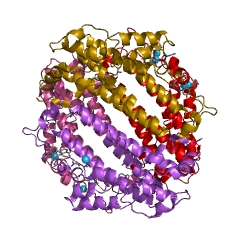Oxygenase

An oxygenase is any enzyme that oxidizes a substrate by transferring the oxygen from molecular oxygen O2 (as in air) to it. The oxygenases form a class of oxidoreductases; their EC number is EC 1.13 or EC 1.14.
Structure
Most oxygenases contain either a metal, usually iron, or an organic cofactor, usually flavin. These cofactors interact with O2, leading to its transfer to substrate.[1]
Oxygenases constitute a major intracellular source of iron and carbon monoxide[2]
Mechanism
Two types of oxygenases are recognized:
- Monooxygenases, or mixed function oxidase, transfer one oxygen atom to the substrate, and reduce the other oxygen atom to water.
- Dioxygenases, or oxygen transferases, incorporate both atoms of molecular oxygen (O2) into the product(s) of the reaction.[3]
Among the most common monooxygenases are the cytochrome P450 oxidases, responsible for breaking down numerous chemicals in the body.
History
Oxygenases were discovered in 1955 simultaneously by two groups, Osamu Hayaishi from Japan[4][5][6] and Howard S. Mason from the US.[7][8] Hayaishi was awarded the 1986 Wolf Prize in Medicine "for the discovery of the oxygenase enzymes and elucidation of their structure and biological importance."[9]
References
- ^ Fetzner, Susanne; Steiner, Roberto A. (2010). "Cofactor-independent oxidases and oxygenases". Applied Microbiology and Biotechnology. 86 (3): 791–804. doi:10.1007/s00253-010-2455-0. PMID 20157809. S2CID 25377247.
- ^ SW, Ryter; J, Alam (April 2006). "Heme oxygenase-1/carbon monoxide: from basic science to therapeutic applications". Physiol Rev. 86 (2). Department of Medicine, Division of Pulmonary, Allergy, and Critical Care Medicine, The University of Pittsburgh School of Medicine: 583–650. doi:10.1152/physrev.00011.2005. PMID 16601269.
- ^ Bugg TDH (2003). "Dioxygenase enzymes: catalytic mechanisms and chemical models". Tetrahedron. 59 (36): 7075–7101. doi:10.1016/S0040-4020(03)00944-X.
- ^ Hayaishi et al. (1955) Mechanism of the pyrocatechase reaction, J. Am. Chem. Soc. 77 (1955) 5450-5451
- ^ Sligar SG, Makris TM, Denisov IG (2005). "Thirty years of microbial P450 monooxygenase research: peroxo-heme intermediates--the central bus station in heme oxygenase catalysis". Biochem. Biophys. Res. Commun. 338 (1): 346–54. doi:10.1016/j.bbrc.2005.08.094. PMID 16139790.
- ^ Hayaishi O (2005). "An odyssey with oxygen". Biochem. Biophys. Res. Commun. 338 (1): 2–6. doi:10.1016/j.bbrc.2005.09.019. PMID 16185652.
- ^ Mason HS, Fowlks WK, Peterson E (1955). "Oxygen transfer and electron transport by the phenolase complex". J. Am. Chem. Soc. 77 (10): 2914–2915. doi:10.1021/ja01615a088.
- ^ Waterman MR (2005). "Professor Howard Mason and oxygen activation". Biochem. Biophys. Res. Commun. 338 (1): 7–11. doi:10.1016/j.bbrc.2005.08.120. PMID 16153596.
- ^ "The Medicine Prize Committee unanimously decided that the Wolf Prize in Medicine for 1986 be awarded to Osamu Hayaishi". Wolf Foundation. Retrieved May 12, 2014.[dead link]